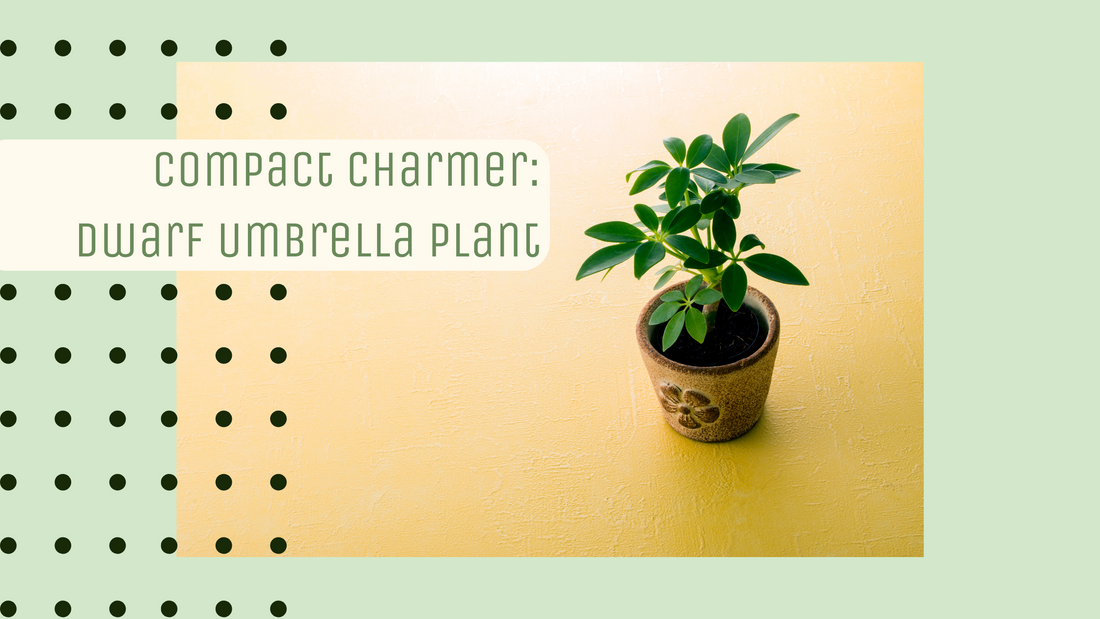
Compact Charmer: Dwarf Umbrella Plant
Share
The Dwarf Umbrella Plant, also known as Schefflera arboricola, is a delightful addition to any home or office. With its charming umbrella-like leaves and compact growth habit, this plant is a favorite for indoor gardeners looking for a low-maintenance yet visually striking plant. Whether you’re new to houseplants or a seasoned plant parent, the Dwarf Umbrella Plant has something to offer. Let’s dive into what makes this plant special and how you can keep it thriving in your space.
Why Choose a Dwarf Umbrella Plant?
If you’re looking for a plant that’s easy to care for, visually appealing, and adaptable to a variety of conditions, the Dwarf Umbrella Plant ticks all the boxes. Here’s why:
Compact Beauty:
Its dense, bushy foliage creates a lush, tropical vibe without taking up too much space.
Resilient Nature:
Known for its hardiness, this plant can adapt to various lighting and care conditions, making it a forgiving choice.
Air Purifier:
Like many houseplants, the Dwarf Umbrella Plant helps improve air quality, giving you cleaner, fresher air to breathe.
Understanding the Dwarf Umbrella Plant
The Dwarf Umbrella Plant is native to Taiwan and Hainan, where it grows as an evergreen shrub. Indoors, it’s often grown as a tabletop plant or small floor plant, depending on how it’s pruned. Its glossy, palmate leaves radiate from a central stem, resembling a miniature umbrella—hence the name.
One of the most endearing qualities of this plant is its versatility. It can be grown as a standard bushy plant, trained into a small tree form, or even incorporated into bonsai projects for those who enjoy creative gardening.
Care Tips for a Happy Dwarf Umbrella Plant
Light Requirements
The Dwarf Umbrella Plant thrives in bright, indirect light but is also tolerant of lower light conditions. However, if you want your plant to grow its best, place it near a north or east-facing window where it can receive filtered sunlight. Avoid direct sun, as this can scorch its delicate leaves.
If you have a variegated variety, note that it will need slightly brighter light to maintain its beautiful markings.
Watering Guidelines
Watering this plant is all about balance. The soil should be kept evenly moist but not soggy. Allow the top inch of soil to dry out between waterings to prevent root rot. Overwatering is one of the few things this hardy plant won’t forgive, so err on the side of caution.
In the winter months, when the plant’s growth slows, you can reduce the frequency of watering.
Humidity and Temperature
The Dwarf Umbrella Plant prefers moderate humidity levels. If your home tends to be dry, especially during the winter, consider misting the leaves or placing a tray of water with pebbles nearby to increase humidity.
Temperature-wise, keep it in a range of 60–80°F. Avoid cold drafts or placing it near heating vents, as sudden changes in temperature can stress the plant.
Soil and Fertilizer
A well-draining potting mix is essential for this plant. Look for a general-purpose mix and consider adding some perlite or coarse sand to improve drainage.
Feed your plant with a balanced, water-soluble fertilizer once a month during the growing season (spring and summer). Cut back on feeding in the fall and winter, when the plant naturally slows its growth.
Pruning and Maintenance
Pruning is key to maintaining the Dwarf Umbrella Plant’s shape and encouraging bushier growth. Trim back leggy stems or any dead or yellowing leaves. If you’d like to keep the plant compact, regular pruning will prevent it from outgrowing its space.
If you’re feeling creative, you can train the plant into a small tree shape by trimming the lower leaves and leaving a few main stems exposed.
Common Issues and Troubleshooting
While the Dwarf Umbrella Plant is relatively low-maintenance, it’s not entirely immune to problems. Here are a few common issues and how to address them:
Yellowing Leaves:
Often a sign of overwatering. Check the soil and adjust your watering routine.
Drooping Leaves:
This can indicate underwatering or exposure to cold drafts.
Pests:
Watch out for spider mites, scale, and mealybugs. Treat infestations with insecticidal soap or neem oil.
Varieties of the Dwarf Umbrella Plant
While the classic green-leafed variety is stunning on its own, there are a few cultivars that add extra flair:
Variegated Dwarf Umbrella Plant:
Features creamy white or yellow splashes on its leaves, adding a bright pop of color to your collection.
Gold Capella:
This variety boasts green leaves with vibrant yellow variegation, perfect for adding a sunny vibe to your indoor space.
Trinette:
Another variegated form, with larger cream and green marbled leaves, making it an eye-catching statement plant.
Styling Your Dwarf Umbrella Plant
The Dwarf Umbrella Plant is as versatile in design as it is in care. Place it in a sleek, modern pot to complement contemporary decor, or opt for a woven basket to highlight its tropical roots. It works beautifully as a standalone statement piece or grouped with other plants for a lush, jungle-like effect.
For smaller spaces, consider placing it on a plant stand to elevate its beauty. Its compact size also makes it a great option for desktops, countertops, or small corners that need a touch of greenery.
Why You’ll Love It
With its adaptability, elegant foliage, and ease of care, the Dwarf Umbrella Plant is a must-have for any plant parent. Whether you’re a beginner looking for a low-maintenance option or an experienced gardener seeking a versatile addition to your collection, this plant delivers.
Ready to bring this compact charmer into your home? Once you’ve got the basics down, the Dwarf Umbrella Plant will reward you with years of lush, green beauty.